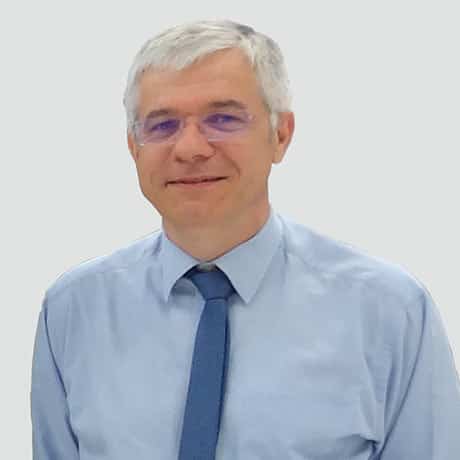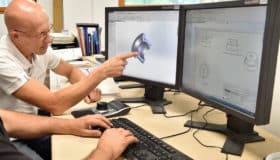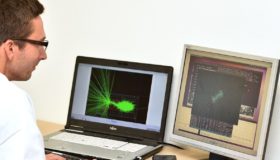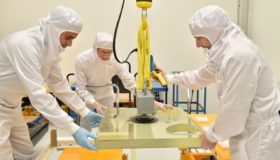
3 questions to Philippe Gervais, PhD in radiopharmacy, international expert with the CEA
Under the aegis of the CAor and Lotus collaborative projects, developed at the molecular and functional imaging centre at Frédéric Joliot Hospital (SHFJ) in Orsay, Lemer Pax has designed, manufactured and delivered four radiosynthesis cells for the CEA, dedicated to the production of Fluorine-18 and Carbon-11.
The goal is to offer an integrated solution for the production of radionuclides and the synthesis of innovative radiopharmaceuticals “by the dose” that can be scaled up quickly to facilitate the emergence of novel radiopharmaceuticals in clinical practice.
Philippe Gervais, PhD in radiopharmacy, international expert with the CEA, head of the CAor project and consultant for Lotus micro fluidics, is extremely pleased about this technological and qualitative leap forward, which will improve the overall safety and working comfort of the personnel concerned.
What are the advantages of using these “new generation” cells, in terms of safety?
Philippe Gervais: These days we’re much more concerned with protecting our operators and the environment than we were in the past. These hot cells are therefore entirely sealed to prevent transfers between the hot cell environment and the outside. During synthesis, the gas compression system connected to the cell exhaust system confines the gas, which could potentially be radioactive, and then allows it to decay before releasing it into the atmosphere.
Regulations and safety standards are constantly evolving, particularly since the creation of the ASN in the early 2000s. Research facilities need to guarantee a constant, high level of security for their staff and the environment. The CAor and Lotus programmes could not have come at a better time, putting the finishing touches to the total overhaul of radiopharmaceutical production at the Orsay laboratories.
Has the rise of personalised medicines influenced your decision to invest in new, cutting-edge production tools?
Philippe Gervais: Without a doubt! These cells are up to pharmaceutical Class C standard, in labs which are also Class C. The circuits in our laboratories and buildings have also been reviewed and updated to make it much easier to isolate different sections and keep the flows separate.
The CAor programme was all about updating our radiopharmaceutical production facilities, medicines which are administered to humans in biomedical research. That meant installing two new cells for Fluoride-18 (75mm of lead protection) and two Carbon-11 cells (also 75mm lead). With the Lotus project, these facilities make it possible for us to rapidly produce bespoke radiopharmaceutical preparations suitable for use on humans. From the time the cyclotron is started until the syringe is ready to be administered, less than 45 minutes should pass with fully customized markers and Fluoride-18 and Carbon-11 radioisotopes. This development process has involved input from firms including PMB, Evéon (precision injection specialists), the Alcen group and the CEA, who have shared the benefits of their experience and technological capabilities. Amongst ourselves, we jokingly refer to it as the Nespresso of radiopharmaceuticals. It’s the biggest breakthrough of recent years! For example, the market authorisation for FDG was very broad and non-specific. Nowadays, our approach is much more focused on bespoke, personalised treatment.
Why did you set up home in Orsay 50 years ago?
Philippe Gervais: The answer is simple: in 1958 we needed to be close to a centre such as CEA Saclay, which was producing radionuclides suitable for human experiments. And we needed to be close to a hospital, such as Orsay, to benefit from the skills of the doctors, nurses and X-ray technicians.
We’ve also had a PET facility since 1975 with the cyclotron CGR 520 MeV, and that was the year we installed our first cells from Lemer Pax. Between 1975 and 2004 Orsay was one of the only PET centres using the TTV01/02 camera technology developed by LETI, allowing for vast improvements in functional imagery during PET scans. In 1992 we installed the first MRI 3.0 Tesla unit, contributing to the development of brain scans on humans. Lab 16 was fitted out with five Lemer Pax cells: two dedicated to Carbon-11 production, two more for Fluorine-18 and one for directing targets and performing less hazardous operations. In 1998 we became the first pharmaceutical institution with a private partner, CiS Bio International, to distribute 18-Fluorodesoxyglucose in France. We continuously produced radiopharmaceutical medicines from 1998 to 2009, while also continuing to operate as a research centre and a conventional nuclear medicine department. This centre has played a big role in the development of PET imaging for neurosciences. We’re particularly specialised in Parkinson’s, Alzheimer’s and multiple sclerosis.








